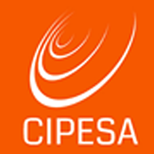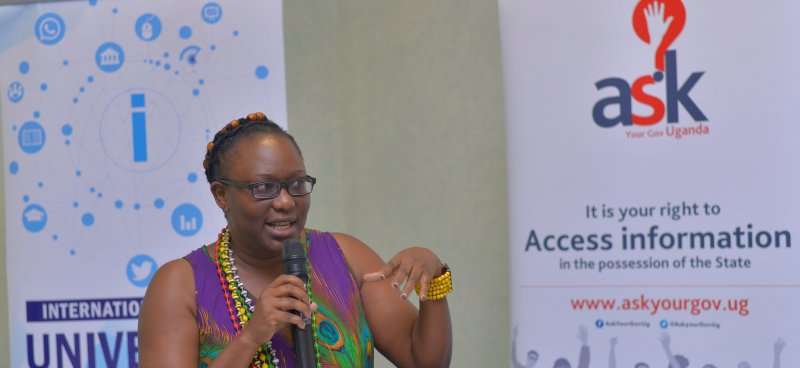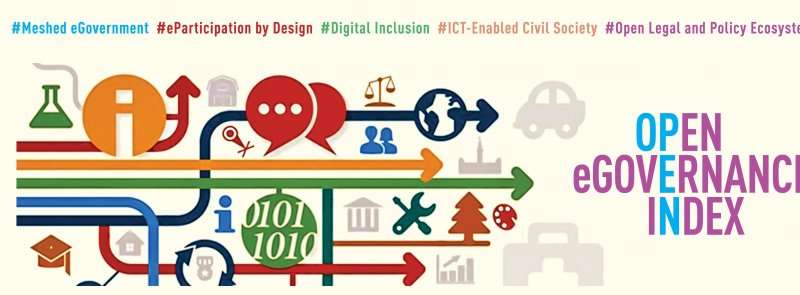By Loyce Kyogabirwe |
Norah Owaraga, a Ugandan researcher, recently narrated her experience on accessing government-held information in the country. She recounted a trip to Tororo district in eastern Uganda where she sought information on Tuberculosis prevalence in prisons. “I was told to go back to the prisons headquarters in Kampala (the capital) to get authorisation yet I had already received clearance from Uganda National Council for Science and Technology (UNCST) and the President’s Office to access government information. Why did I have to travel back to Kampala when I had all the clearance?” asked Owaraga.
Her question was directed at Frank Baine, the spokesperson of Uganda Prisons, during a dialogue held in Kampala to commemorate the International Day for Universal Access to Information, which falls on September 28.
In his response, Baine quoted section 4.8.1(i) of the Code of Conduct and Ethics for Uganda Public Service, 2006 and the Official Secrets Act 1964, stating that public officials are custodians of information that comes into their possession during the course of duty. “Without due permission from an authorising officer, such information cannot be communicated,” explained Baine. In Owaraga’s case, he said the authorising officer was not within the UNCST or the President’s office. Rather, it was the head of Uganda Prisons who had the mandate to authorise the release of the information.
Owaraga’s experience mirrors the challenges faced by Ugandan citizens in realising the right to access information. The right of access to information is enshrined in article 41 of the Constitution of the Republic of Uganda, 1995 which provides that, “Every citizen has a right of access to information in the possession of the state or any other organ of the state except where the release of the information is likely to interfere with the security of the state or the right to the privacy of any other person”. Uganda was among the first African countries to enact a right to information law, the Access to Information Act (ATIA), 2005 and later the Access to Information Regulations, 2011.
The ATIA is aimed at promoting transparency and accountability in all organs of the state by providing the public with timely, accessible and accurate information. Baine’s response instead highlights that a culture of secrecy still persists, with limited proactive release of information by public agencies and denial of citizens’ requests for information.
Other challenges that were raised during the dialogue include the high costs of accessing information, lack of knowledge of the provisions of ATIA among citizens and public officials, and the tedious procedures of requesting for information – all of which impact on the level of citizens’ information requests.
Despite the challenges, the government has taken some steps to promote access to public information. Speaking at the dialogue, Moses Watasa, Commissioner of Information Dissemination at the Ministry of ICT and National Guidance, explained that the Ministry is working to sensitise all government ministries, departments and agencies (MDAs) on ATIA as well as strengthening communication departments within MDAs and local governments with the aim of improving information gathering and dissemination.
Furthermore, the ministry has developed a centralised government information web portal (www.gov.go.ug), which functions as a gateway to all other government websites. The portal is reinforced by the ministry’s requirement for all MDAs to have a communications officer, functional website, a presence on social media and email addresses for officials to ensure public accessibility.
Watasa acknowledged that there has been a culture of secrecy among public officials further compounded by internal bureaucracies. He stated that the government was working to review archaic guidelines that restrict responsiveness or proactive disclosure by public officers.
Meanwhile, according to Watasa the government is also due to launch Open Government Sessions aimed at bridging the information gap between citizens and duty bearers. The sessions, which will be hosted monthly, will involve different MDAs interfacing with the public on functions, ongoing activities, budget allocations and expenditure and feedback. It is expected that the sessions will be broadcast live on TV and leverage social media platforms to allow remote participation.
However, it remains unclear when the archaic laws and guidelines will be reviewed and implemented to ease citizens’ access of public information. It is only through improved access to information that there can be increased social accountability and government transparency towards improved service delivery and greater citizen participation in governance and democratic processes.
The dialogue on access to information in Uganda was organised by the Collaboration on International ICT Policy for East and Southern Africa (CIPESA) in partnership with the Ministry of ICT and National Guidance in the context of the ICT4Democracy in East Africa initiative’s objective to engage stakeholders on supportive policies and practices for human rights and democratic governance in East Africa. It brought together 50 participants including public officials, policy makers, civil society, media, and scholars to reflect on the role of information in improving service delivery and accountability in Uganda.
Uganda On the Right Path Towards Realising Open eGovernance
By Lilian Nalwoga |
The Uganda government has identified Information and Communication Technology (ICT) as one of the key drivers of socio-economic transformation in the country. This is evidenced in its presence as a priority in national development frameworks such as Vision 2040 and the National Development Plan II (NDP II) which spans from 2015 to 2020.
Extension of the National Broadband Infrastructure (NBI) which to date has connected a total of 133 Government Ministries, Departments and Agencies (MDAs) sites out of which 94 are currently utilising internet delivered over the NBI. Further the NBP II also prioritises the construction of incubation hubs and ICT parks.
These frameworks have recently been measured for the level of governmental openness they enable. Open e-Governance is measured in terms of the ability of the different actors in the internet access eco-system , including governments, business and civil society, to participate in decision-making processes through the use of information and communication technologies.
In March 2017, CIPESA conducted a study into the State of Open eGovernance in Uganda. The study forms part of the Open e-Governance Index (OeGI), an action-research project implemented by the Foundation for Media Alternatives (FMA) `that aims to measure the state of ‘openness’ in the implementation of ‘e-governance’ around the world.
The OeGI index comprises four key dimensions which are measured for different qualities with the highest score being 1 a dimension can score. The study revealed that the dimension Uganda scored highest in was digital inclusion at 1.00 and scored lowest in the dimensions on meshed eGovernment, eParticipation channels and ICT empowered civil society respectively.
Dimension and Country Index Scores
| Dimension | Description | COL | IND | PAK | PHI | UGA | Average |
| Meshed eGovernment | The ability of governments to provide citizen centric online services. | 0.92 | 0.54 | 0.38 | 0.72 | 0.35 | 0.58 |
| eParticipation | new, digital medium for public participation | 0.51 | 0.82 | 0.32 | 0.65 | 0.36 | 0.53 |
| Digital Inclusion | Presence of policies and programs that support the public’s wider use of ICT | 0.83 | 0.50 | 1.00 | 0.33 | 1.00 | 0.73 |
| ICT empowered civil society | ICT readiness and utilisation CSOs and other non-State organisations such as political parties and people’s organisations. | 0.63 | 0.54 | 0.71 | 0.75 | 0.39 | 0.60 |
| Enabling / constraining environment | Extent that the government recognizes and fosters the right to freedom of expression, right over personal communication, cultural freedom and the use of local languages government’s ability to place its public functions online, which comprises many aspects of ICT enablement. | 0.81 | 0.78 | 0.63 | 0.63 | 0.78 | 0.73 |
| Average | 0.74 | 0.64 | 0.61 | 0.62 | 0.58 | 0.64 |
In terms of Meshed eGovernment, Colombia scored the highest at 0.92, followed by the Philippines at 0.72, Indonesia at 0.54, Pakistan at 0.38 and Uganda at 0.35. In the eParticipation channel dimension, Indonesia had the highest score at 0.82, followed by the Philippines at 0.63, Colombia at 0.51, Uganda at 0.36 and Pakistan at 0.32.
Pakistan and Uganda scored 1.00 in the Digital Inclusion dimension, followed by Colombia at 0.83, then Indonesia at 0.50, and the Philippines at 0.33. In the ICT empowered civil society dimension, the Philippines scored the highest at 0.75, followed by Pakistan at 0.71, Colombia at 0.63, Indonesia at 0.54 and Uganda at 0.39. In the Enabling/Constraining Environment dimension, Colombia scored the highest at 0.81, followed by Indonesia and Uganda both at 0.78, then Pakistan and the Philippines both with a score of 0.63.
Uganda’s highest score in Digital Inclusion reflects the presence of universal access and literacy policies in place, such as the National ICT Policy 2014, Rural Communications Development Fund Policy 2001 and draft broadband strategy although adoption and implementation is still challenge.
Despite, having the lowest average index score of 0.58 out of 1, the study indicates that Uganda is moving towards the right path to implementing eGovernance. This includes a growing number of e- services being offered by public agencies such as e-filling for taxes, presence of enabling laws and policies, some of which are positive for citizen participation, free expression and open governance and a growing use of ICT by both governments and Civil Society Organisations (CSOs).
Nonetheless, slow uptake and uncoordinated implementation of eGovernance across government Ministries, Departments and Agencies (MDAs) is still hampering its full adoption. Thus, more commitment towards adoption of policies especially those focusing on promoting open data, open standards and privacy and data protection is needed.
Full findings of the study can be found here.


